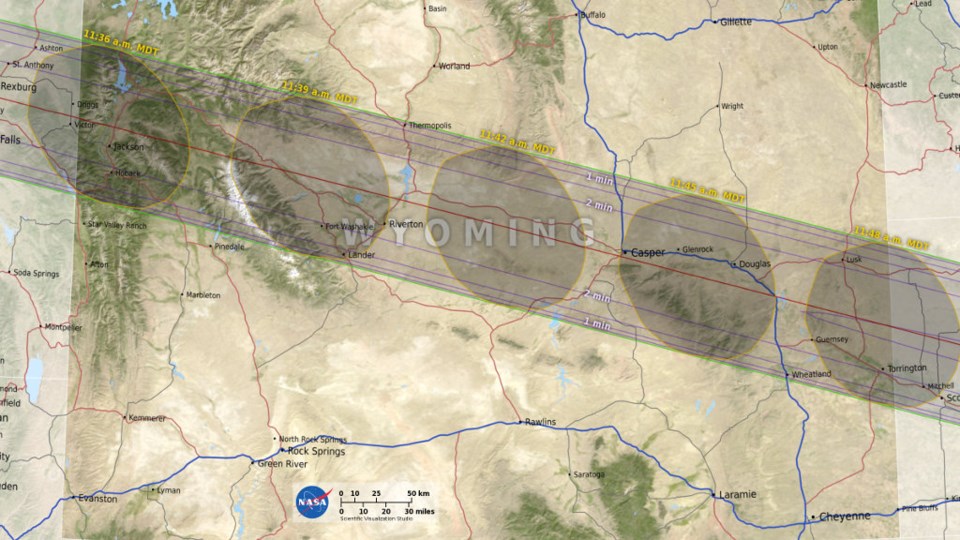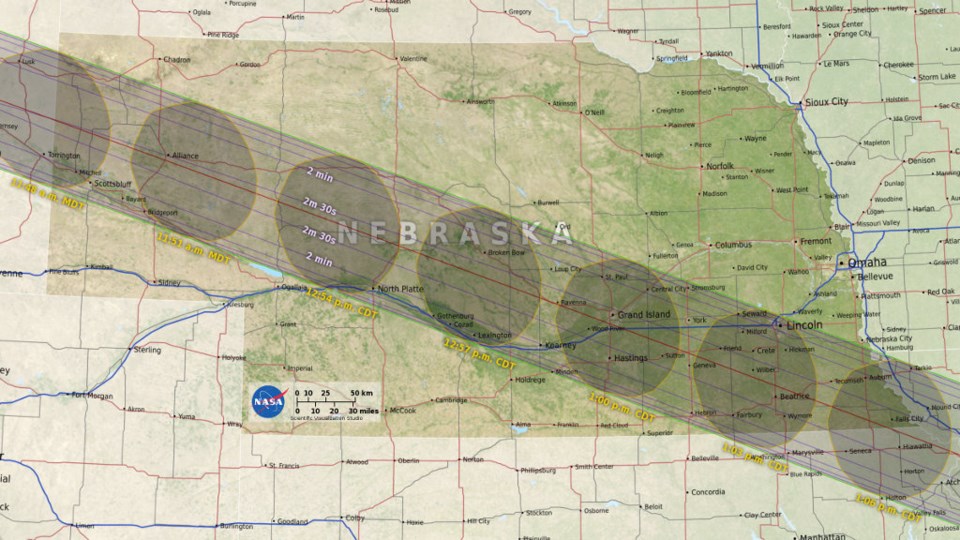This content was originally published by the Longmont Observer and is licensed under a Creative Commons license.
By: John Ensworth
There is (for some) a once-in-a-lifetime total solar eclipse coming to the United States in exactly one month. This is the first total solar eclipse to hit the U.S. since February 26, 1979.
The path of totality (the place you MUST be) travels across Wyoming and Nebraska including Casper, WY and Alliance, NE. See Figures 8 and 9 for the path closest to Longmont. The moon will cover only about 94% of the Sun in Longmont. That is NOT enough dimming to allow you to look at the sun or enjoy the eclipse.
No one knows exactly how many people will travel into the path of the shadow of the moon, but I am guessing that sometime Sunday night August 20th, northbound I-25 will slow to a crawl or come to a stop. Maybe the really bad traffic won’t form until 3am or 6am on the 21st, but it will be hard to impossible to get up there if you wait too long. The bad news is that hotels and campgrounds have been booked for 1-2 years already, so you are unlikely to find any accommodations. Towns of a few hundred or a few thousand may swell to 10,000’s of people. Gas stations could go dry, groceries could vanish up there, water may be tricky to find, and cell service and internet access may vanish. It will be quite an interesting day for this path (much worse near the coasts of the U.S. – Oregon and South Carolina). The next (even longer totality) total solar eclipse in the U.S. will be April 8th, 2024. That eclipse will travel up through Texas, Oklahoma, Arkansas, Missouri, Illinois, Indiana, Ohio, Pennsylvania, New York, Vermont, and Maine.
You can read more about these eclipses at the main links below. I’ll cover weather forecasting for the eclipse (you don’t want to dry camp for two days in an empty Nebraska field only to get clouded out!), traffic information, eye protection, simple guides to photography, and predictions on the experience in the days to come in this feature.
Our first batch of useful Eclipse information links:
The NASA Eclipse Website: https://eclipse.gsfc.nasa.gov/SEgoogle/SEgoogle2001/SE2017Aug21Tgoogle.html
The August 21, 2017 NASA Eclipse site: https://eclipse2017.nasa.gov/
Figure 8: The path of totality in Wyoming.

Figure 9: The path of totality in Nebraska.

*** This feature will run as close to daily as possible in this location on the Longmont Observer. This article will provide a brief discussion concerning the ‘why’ behind the weather with a focus on severe weather, unusual weather, and snow (especially trying to predict snow depth and its human impact in Longmont).***
Bio:
John Ensworth works from Longmont as the Principle Investigator for the NASA Science Mission Directorate Earth and space science education product review. He is in his 14th year running this review. He is an astronomer (from the 2nd grade onward) and became a meteorologist (in the 5th grade) when a thunderstorm in Arizona rained on his telescope when the weather service had only forecasted a 10% chance of rain. He has college degrees in physics and astronomy and climatology and a graduate degree in meteorology and earth science. He lectures at the Little Thompson Observatory in Berthoud, the Estes Park Memorial Observatory in Estes Park, and for a number of online universities. He built and runs a backyard observatory near Pace and 17th in northeast Longmont where he has lived for 8 years with his wife, daughter, son, and two cats. Invitations to open house nights at this observatory, LTO, and EPMO will be posted with future discussions when they are scheduled.
Forecasting severe weather and snow amounts via text lead to this column. He began texting friends about the weather right after the September 2013 flood. The readers of this column will, hopefully, keep him honest in what he ‘thought’ he had forecasted for ‘the most recent’ storm.



